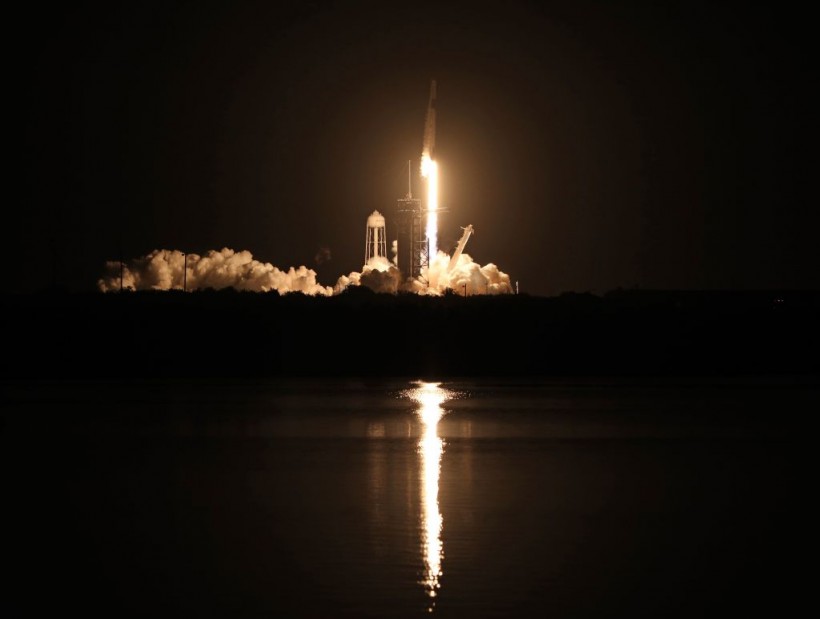A SpaceX Falcon 9 rocket launched from Cape Canaveral Air Force Station on its fifth try on Monday. The spacecraft delivered an Italian Earth observation satellite into orbit in one of the most visually stunning launches.
The launch was postponed three times in the previous week, the most recent being on Sunday, when the countdown was paused just 33 seconds before liftoff owing to a cruise ship crossing into the hazard zone beneath the rocket's intended flight path.
CBS News said the clear sky allowed locals and visitors, including passengers on cruise ships, to view the entire event from takeoff to landing. Twin shotgun-like sonic bangs shook observers closer to the Space Force station.

A SpaceX Falcon 9 rocket lifts off from launch complex 39A at the Kennedy Space Center in Florida on November 15, 2020.
SpaceX Falcon 9 Rocket Launches Italian Satellite
The Italian Space Agency's COSMO-SkyMed Second Generation FM2 satellite was launched into orbit by SpaceX Falcon 9 rocket. It's the second of four new satellites that will replace four that were launched between 2007 and 2010 and provide defense, environmental, and other observations for Italy and other Mediterranean states.
SpaceX successfully recovered its first-stage rocket at Canaveral's Landing Zone 1, marking the 104th time the firm has been able to do so. This was the booster's third flight, and each of the fairing sections had flown on three prior flights.
Falcon 9’s first stage has landed on Landing Zone 1 pic.twitter.com/Vfc7UDaeun
— SpaceX (@SpaceX) January 31, 2022
According to the Orlando Sentinel, several launches from Canaveral and Kennedy have taken a southerly trajectory, prompting Space Launch Delta 45, the Space Force group that oversees both Cape Canaveral and Patrick Space Force Base, to try to spread the word so that planes and watercraft don't interfere with the space.
ALSO READ: SpaceX Wants to Launch Rockets Weekly to Achieve Elon Musk's Goal of Having 52 Missions in 2022
The footage of the stage separation two and a half minutes after launch was awe-inspiring. Usually, SpaceX broadcasts this section from a camera mounted on the Falcon 9's upper stage. Still, this time it used a powerful ground camera to film the separation. The video is embedded below.
View of Falcon 9's stage separation from ground cameras pic.twitter.com/lHDfQlKgZI
— SpaceX (@SpaceX) January 31, 2022
During the webcast of Monday's launch (via Space.com), SpaceX production manager Jessie Anderson said today's flight was the first time a Heavy side rocket has been rebuilt and flown alone as a Falcon 9. This first stage has already flown twice as a side booster on SpaceX's enormous Falcon Heavy rocket.
SpaceX's long-term aims include decreasing the cost of flying to the point that grandiose exploration accomplishments like Mars colonization are economically possible. Indeed, according to Anderson, SpaceX planned to retrieve the CSG-2 mission's payload fairing - the protective "nose cone" that covers a payload during launch - on Monday to reuse it later.
Liftoff! pic.twitter.com/aJG87rLr0U
— SpaceX (@SpaceX) January 31, 2022
About Italian Satellite
The Italian Space Agency, the Italian Ministry of Defense, and the Italian Ministry of Education, Universities, and Scientific Research contribute to the Cosmo-SkyMed Second Generation initiative. The system consists of two satellites that use synthetic aperture radar to study the Earth (SAR). CSG is a more advanced version of the Cosmo-SkyMed system.
COSMO-SkyMed Second Generation's objective, according to European Space Agency officials, is to monitor the Earth for the sake of emergency prevention, strategy, science, and commercial interests. ESA said the satellite also delivers data on a worldwide scale to aid risk management, cartography, forest and environment protection, natural resource exploitation, land management, military and security, marine surveillance, and food and agricultural management.
CSG-1, the first CSG satellite, was launched in December 2019 from Kourou, French Guiana, on an Arianespace Soyuz rocket, and is now in a sun-synchronous polar orbit at an altitude of 385 miles (620 kilometers). CSG-2 will be in the same trajectory as CSG-1.
RELATED ARTICLE: SpaceX to Reuse Dragon Spacecraft Fleet After Rocket Booster from NASA Crew-1 'Leaned'
Check out more news and information on SpaceX in Science Times.



![Earth's Quasi-Moon Kamo‘oalewa Could Originate From Lunar Surface Not Asteroid Belt [Study]](https://1721181113.rsc.cdn77.org/data/thumbs/full/53275/89/56/50/40/earths-quasi-moon-kamo-oalewa-could-originate-from-lunar-surface-not-asteroid-belt-study.png)










